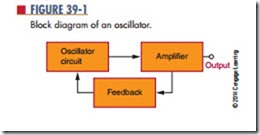Fundamentals of oscillators
An oscillator is a circuit that generates a repetitive AC signal. The frequency of the AC signal may vary from a few hertz to many millions of hertz. The oscillator is an alternative to the mechanical generator used to produce electrical power. The advantages of the oscillator are the absence of moving parts and the range over which the AC signal can be produced. The output of an oscillator may be a sinusoidal, rectangular, or sawtooth waveform, depending on the type of oscillator used. The main requirement of an oscillator is that the output be uniform; that is, the output must not vary in either frequency or amplitude.
When an inductor and a capacitor are connected in parallel, they form what is called a tank circuit. When a tank circuit is excited by an external DC source, it oscillates; that is, it produces a back-and-forth current flow. If it were not for the resistance of the circuit, the tank circuit would oscillate forever. However, the resistance of the tank circuit absorbs energy from the cur- rent, and the oscillations of the circuit are dampened.
For the tank circuit to maintain its oscillation, the energy that is dissipated must be replaced. The energy that is replaced is referred to as positive feedback. Positive feedback is the feeding back of a portion of the output signal into the tank circuit to sustain oscillation. The feedback must be in phase with the signal in the tank circuit. Figure 39-1 shows a block diagram of an oscillator. The basic oscillator can be broken down into three sections. The frequency-determining oscillator circuit is usually an LC tank circuit. An amplifier
increases the output signal of the tank circuit. A feed- back circuit delivers the proper amount of energy to the tank circuit to sustain oscillation. The oscillator circuit is essentially a closed loop that uses DC power to maintain AC oscillations.
Questions
1. What is an oscillator?
2. How does a tank circuit operate?
3. What makes a tank circuit continue to oscillate?
4. Draw and label a block diagram of an oscillator.
5. What are the functions of the basic parts of an oscillator?
